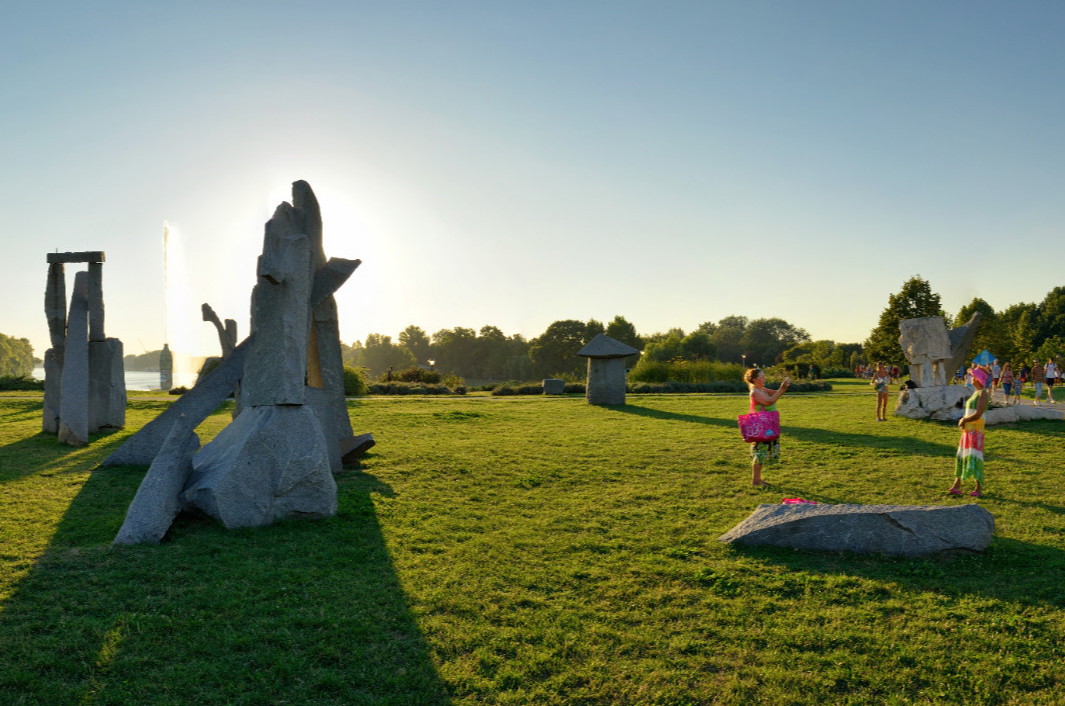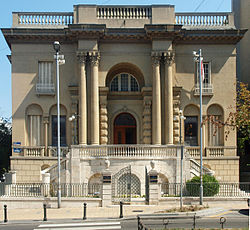
Belgrade is a modern city with a vast historical legacy, and one of the oldest continuously inhabited cities in Europe and the world. It has been founded by Celts in 279 BC, settled by Slavs in 520s, and it is famous for being battled over in 115 wars & razed 44 times, and for its centuries-long blend of European & Asian cultures. It is the capital and largest city of Serbia, situated at beautiful confluence of Danube and Sava rivers, with impressive medieval fortress, pedestrian zones & vibrant bohemian quarters, and plethora of museums, temples, and churches. The Tourist Organization of Belgrade presents a large number of attractions to visit, of which a small selection is listed below:
Kalemegdan Park
This is the biggest park in the city and it’s located in the very centre of the Belgrade Fortress. The plateau in the middle of the Fortress was  transformed into a park during the last few decades of the 19th century. The construction of Veliko stepenište (the Grand Staircase) and the decoration of the walkways with flowerbeds during the period between two world wars, really helped bring the one-of-a-kind view of the Sava and Danube river confluence to life.
transformed into a park during the last few decades of the 19th century. The construction of Veliko stepenište (the Grand Staircase) and the decoration of the walkways with flowerbeds during the period between two world wars, really helped bring the one-of-a-kind view of the Sava and Danube river confluence to life.
Museums, galleries, cultural and historical monuments, the fortress itself, the zoo, fun activities and being able to relax in its nature make Kalemegdan the perfect place to spend an entire day touring this park.
Skadarlija
When you enter this street from the hustle and bustle of busy Belgrade, its as if the gates from a past time open and lead you into this corner where you can feel the historical atmosphere. Belgrade citizens and guests alike excitedly

come to spend their nights in this cobblestoned street with the aim to experience the essence of a past time. Skadarlija became a bohemian part of the city at the turn of the 20th century when actors, writers and painters moved to there, and the taverns of Skadarlija became the gathering places of the most famous individuals who were part of Belgrade culture.
The house where the well-known Serbian writer and painter Đura Jakšić spent his life was turned into a meeting point for poets during their nights in Skadarlija. This Belgrade quarter is compared to the Montmartre in Paris in terms of the appearance and the cheerful arty atmosphere. In present day restaurants of Skadarlija besides traditional specialties, the sounds of urban traditional folk music and the greetings you will receive from the lady of Skadarlija will help you experience the atmosphere of the bohemian Belgrade from the past.
Hram Svetog Save
 You will see the monumental structure of St. Sava Church from whatever side you approach the center of Belgrade. It was erected on Vračar hill and it is one of the largest orthodox churches in the world. It was built where, according to legend, the remains of St. Sava, the most significant Serbian saint, the first archbishop and founder of the Serbian Orthodox Church from the 13th century, were burned during the Turkish rule.
You will see the monumental structure of St. Sava Church from whatever side you approach the center of Belgrade. It was erected on Vračar hill and it is one of the largest orthodox churches in the world. It was built where, according to legend, the remains of St. Sava, the most significant Serbian saint, the first archbishop and founder of the Serbian Orthodox Church from the 13th century, were burned during the Turkish rule.
Knez Mihailova
If you decide to get to know the center of Belgrade better by walking, then Knez Mihailova Street and its surroundings are ideal for that. The street rests on the remains of the once mighty ancient Singidunum built by the Romans, and today connects Terazije Square with Belgrade Fortress and Kalemegdan Park.

When the wealthiest and most influential families erected houses on this street in the 1980s, it became the city's most vibrant shopping mall with elite Belgrade shops and the main promenade of Belgrade. Due to its great historical and cultural significance, the street is protected by the state. There are numerous historical buildings, monuments and cultural institutions. This street is never empty, with its centerpiece full of Belgrade's favorite coffee restaurants. Walkers, street musicians and singers are part of her colorful everyday life.
Avala Tower
This favorite spot for an outing in Belgrade offers the opportunity for rest and recreation throughout the year. The Avala Tower, erected as a replica of the old one from 1965, also with a telecommunications function, dominates Avala, one of the symbols of the city. It is a real pleasure to climb in one of the two elevators to the top of this tallest structure in the Balkans and look at the entire city and its surroundings from the cafe Panorama.
Ada Ciganlija
 This favorite spot for an outing in Belgrade offers the opportunity for rest and recreation. Ada Ciganlija, colloquially shortened to Ada, is a river island that has artificially been turned into a peninsula, located in the Sava River's course through central Belgrade. The name can also refer to the adjoining artificial Lake Sava and its beach. To take advantage of its central location, over the past few decades, it was turned into an immensely popular recreational zone, most notable for its beaches and sports facilities, which, during summer seasons, can have over 100,000 visitors daily, and up to 300,000 visitors over the weekend.
This favorite spot for an outing in Belgrade offers the opportunity for rest and recreation. Ada Ciganlija, colloquially shortened to Ada, is a river island that has artificially been turned into a peninsula, located in the Sava River's course through central Belgrade. The name can also refer to the adjoining artificial Lake Sava and its beach. To take advantage of its central location, over the past few decades, it was turned into an immensely popular recreational zone, most notable for its beaches and sports facilities, which, during summer seasons, can have over 100,000 visitors daily, and up to 300,000 visitors over the weekend.
Nikola Tesla museum

The Nikola Tesla Archive was inscribed on UNESCO's Memory of the World Programme Register in 2003 due to its critical role regarding history of electrification of the world and future technological advancements in this area.